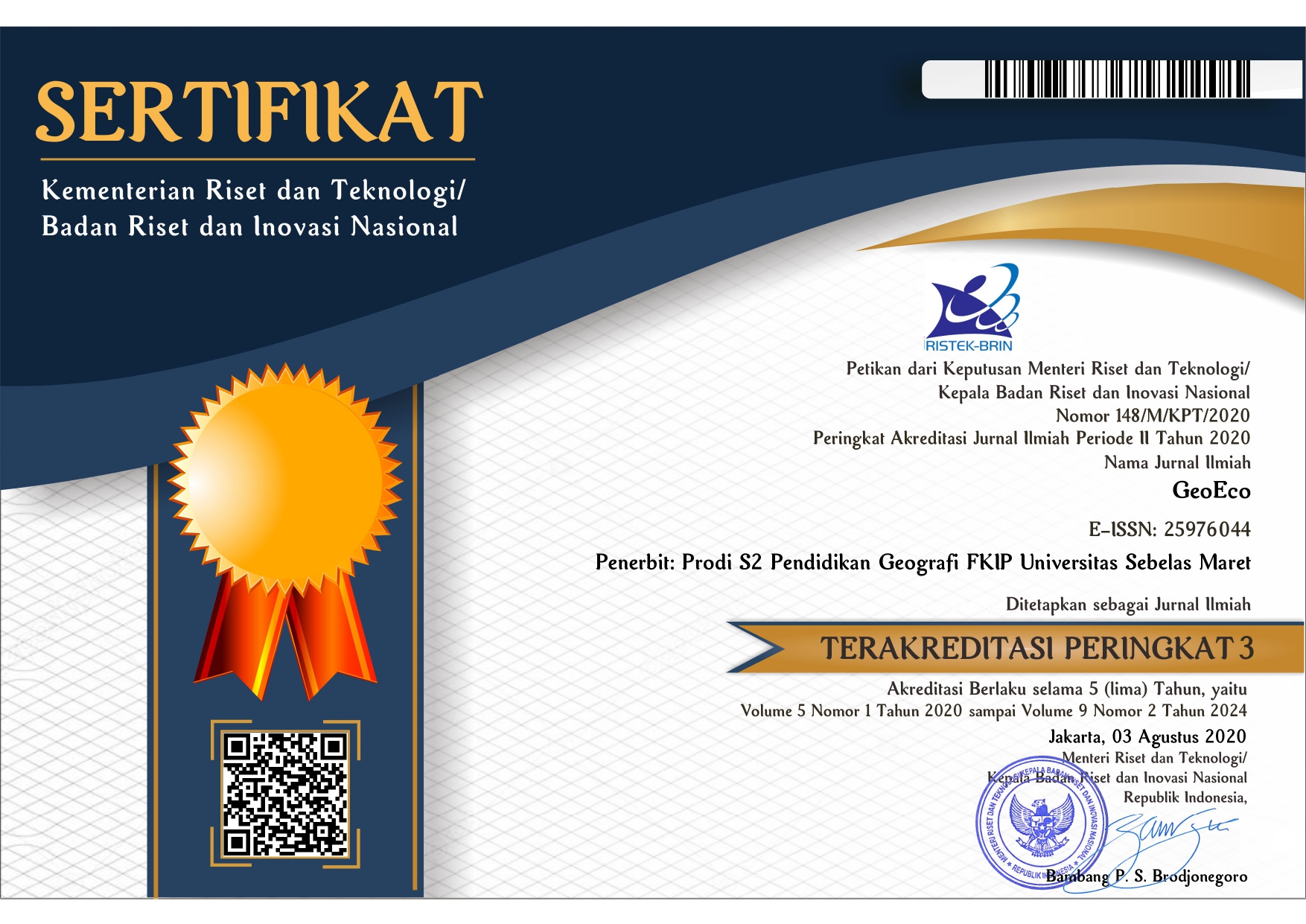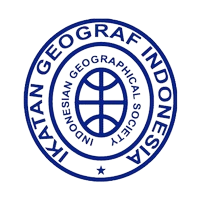SPATIAL DISTRIBUTION OF HOTSPOTS USING S-NPP VIIRS FOR EARLY DETECTION OF POTENTIAL FIRE
Abstract
Fire is a disaster and its frequency is increasing every year. Seeing this, it is very important to know the spatial distribution of hotspots to determine the potential for fires in each area. Based on this, it is necessary to conduct research with the title "Spatial Distribution of Hotspots Using S-NPP VIIRS for Early Detection of Potential Fires". This research includes the type of descriptive research. The population in the study were all hotspots in Banjar Regency, South Kalimantan Province. Hotspots were taken from the results of the S-NPP VIIRS satellite imagery recording from 2012-2021. The number of samples is equal to the number of populations. The data analysis technique uses nearest neighbor analysis and descriptive analysis which is processed using Arc GIS software. The research results show that fires occur during the dry season, namely in July, August, September and October. Spatial distribution of hotspots from the results of S-NPP VIIRS satellite imagery based on the accuracy of the most confidence level in July, August, September and October. If the spatial distribution of hotspots is known, it can be used as an early detection effort. Early detection is carried out as an effort to prevent and control fires with a greater negative impact. In addition, with the existence of an early warning system, the community is better prepared to deal with fires so that the negative impacts that may arise due to fires can be minimized, including loss of life and property.
Keywords
Full Text:
PDFReferences
Adiputra, Agung, Baba Barus. 2018. Analisis Risiko Bencana Kebakaran Hutan dan Lahan di Pulau Bengkalis. Jurnal Geografi Edukasi dan Lingkungan. Volume 1, Nomor 2.
Athifaturrofifah, A., Goejantoro, R., & Yuniarti, D. (2020). Perbandingan Pengelompokan K-Means dan K-Medoids Pada Data Potensi Kebakaran Hutan/Lahan Berdasarkan Persebaran Titik Panas. EKSPONENSIAL, 10(2), 143-152.
Almegi, A., Akmal, A., Alfiah, A., Nelvawita, N., & Novita, Y., (2022). Sebaran Spasial Titik Panas (Hotspot) Berdasarkan Penutupan Lahan di Kabupaten Pesisir Selatan. EL-JUGHRAFIYAH, 2(1), 16-21.
Anastasia, A., Putra, Y. S., & Adriat, R. Studi Distribusi Tingkat Bahaya Kebakaran Menggunakan Fire Weather Index (FWI) di Kalimantan Barat. PRISMA FISIKA, 9(2), 179-182.
Arifudin, A., Syahza, A., Kozan, O., Mizuno, K., Mizuno, K., Isnaini, Z. L., ... & Hasrullah, H. (2019, January). Dinamika Penggunaan, Kebakaran, dan Upaya Restorasi Lahan Gambut: Studi Kasus di Desa Tanjung Leban, Bengkalis. In Unri Conference Series: Agriculture and Food Security (Vol. 1, pp. 40-45).
Arisandi, D., Syamsuadi, A., Gafar, T. F., Hartati, S., & Anugerah, M. F. (2020). Pembinaan Masyarakat Peduli Api Sebagai Bentuk Partisipasi Warga Desa Dayun Dalam Menangani Bencana Kebakaran Lahan. IKRA-ITH ABDIMAS, 3(3), 34-37.
Asyrowi, H., Saharjo, B. H., & Putra, E. I. (2021). Analisis Pola Sebaran Hotspot di Taman Hutan Raya Raden Soerjo. Jurnal Penelitian Hutan dan Konservasi Alam, 18(2), 151-165.
Csiszar, I. A., J.T. Morisette, and L. Giglio. (2006). Validation of Active Fire Detection from Moderate-Resolution Satellite Sensors: The MODIS Example in Northern Eurasia. IEEE Transactions on Geoscience and Remote Sensing, Vol. 44, No. 7, July.
Dahliani, Soemarno, I., & Setijanti, P. (2015). LOCAL WISDOM IN BUILT ENVIRONMENT IN GLOBALIZATION ERA. International Journal of Education and Research, 3(6), 157–166.
Endrawati, & Yusnita, R. (2015). Analisis Data Titik Panas (hotspot) dan Kebakaran Hutan dan Lahan 2015.
Giglio, L., T. Loboda, D.P. Roy, B. Quayle, C. O. Justice. (2009). An active-fire based burned area mapping algorithm for the MODIS sensor. Remote Sensing of Environment 113, 408–420.
Giglio, L. (2015). MODIS Collection 6 Active Fire Product User's Guide Revision A. Department of Geographical Sciences. University of Maryland.
Hairumini, Setyowati, D. L., & Sanjoto, T. B. (2017). Kearifan Lokal Rumah Tradisional Aceh sebagai Warisan Budaya untuk Mitigasi Bencana Gempa dan Tsunami. Journal of Educational Social Studies, 6(1), 37–44.
Handayani, T., Santoso, A. J., Dwiandiyanta, Y. (2014). Pemanfaatan Data Terra Modis Untuk Identifikasi Titik Api Pada Kebakaran Hutan Gambut (Studi Kasus Kota Dumai Provinsi Riau). Seminar Nasional Teknologi Informasi Dan Komunikasi 2014 (Sentika 2014).
Herawati H, Santoso H. 2011. Tropical forest susceptibility to and risk of fire under changing climate: A review of fire nature, Policy and Institutions in Indonesia. Forest Policy and Economics, 227 - 233.
Januarisky, H. A. (2012). Pola Sebaran Titik Panas (Hotspot) Dan Keterkaitannya Dengan Perubahan Penggunaan Lahan (Studi Kasus: Provinsi Kalimantan Barat). Skripsi. Program Studi Manajemen Sumberdaya Lahan Departemen Ilmu Tanah Dan Sumberdaya Lahan Fakultas Pertanian Institut Pertanian Bogor.
Khairani. 2016. Penelitian Geografi Terapan. Padang: UNP PRESS
KLHK. (2016). Peraturan Menteri Lingkungan Hidup dan Kehutanan No P.32/MenLHK/Setjen/Kum.1/ 3/2016.
Maliki, R. Z., (2022). Riverbank Erosion in Part of Tibo Village, Donggala Regency. GeoEco, 8(1), 12-24.
Marlina, Sumarmi, & Astina, I. K. (2020). Sustainable marine ecotourism management: A case of marine resource conservation based on local wisdom of bajo mola community in wakatobi national park. Geojournal of Tourism and Geosites, 32(4), 1317–1323. https://doi.org/10.30892/GTG.3241 9-575
Meiwanda, G. (2016). Kapabilitas Pemerintah Daerah Provinsi Riau: Hambatan dan Tantangan Pengendalian Kebakaran Hutan dan Lahan. Jurnal Ilmu Sosial Dan Ilmu Politik, 19(3), 251. https://doi.org/10.22146/jsp.15686
Mustamin, N. F., Zulkarnain, A. F., & Ramadhan, M. R. B. (2021). Sistem Informasi Geografis untuk Sebaran Titik Panas (Hotspot) di Kalimantan Selatan Menggunakan Metode Clustering. In Prosiding Seminar Nasional Lingkungan Lahan Basah (Vol. 6, No. 3).
Muliono, R., & Sembiring, Z. (2019). Data Mining Clustering Menggunakan Algoritma K-Means Untuk Klasterisasi Tingkat Tridarma Pengajaran Dosen. Computer Engineering, Science and System Journal, 4(2), 272–279.
Nurani, I. W., Wibowo, S. B., & Anggraeni, R. D., (2022). Spatial Distribution of Eco-Friendly Coffee Shops in Malang City. GeoEco, 8(1), 98-112.
Nur, I. L. (2020). Analisa Spasial Hotspot di Kabupaten Bengkalis Provinsi Riau (Doctoral dissertation, STKIP PGRI Sumatera Barat).
Novitasari, N. (2018, October). Pengaruh karakteristik gambut terdegradasi terhadap kebakaran lahan gambut (Studi kasus lahan gambut PLG Blok A di Kalimantan Tengah). In Prosiding Seminar Nasional Lingkungan Lahan Basah (Vol. 3, No. 2).
Page S.E., Hooijer, A. 2016. In the line of fire: the peatlands of Southeast Asia. Philosophical Transaction Royal B. 371, p. 1-9.
Putra, I. D. G. A., Heryanto, E., Sopaheluwakan, A., Pradana, R. P., & Haryoko, U. (2019, February). Sebaran Spasial dan Temporal Titik Panas (Hotspot) di Indonesia dari Satelit Modis dengan Metode Gridding. In Seminar Nasional Geomatika (Vol. 3, pp. 1123-1128).
Purnomo, H., Shantiko, B., Sitorus, S., Gunawan, H., Achdiawan, R., Kartodihardjo, H., & Dewayani, A. (2017). Fire economy and actor network of forest and land fires in Indonesia Forest Policy and Economics, 78.
Rizki, I. A., Bintoro, H., Rahman, P., Realita, A., & Deta, U. A. Profile of Community Understanding and Literacy About Disaster Risk Mitigation: The Responses of Java South Coast Community Against Megathrust Earthquake and Tsunami Prediction. GeoEco, 8(1), 62-76.
Sahardjo BH. 1999. Study on Forest Fire Prevention for Fast Growing Tree Species Acacia Mangium Plantation in South Sumatera, Indonesia. Kyoto University, Graduate School of Agriculture. p. 33-39.
Sahardjo BH. 1999. H. Watanabe, E.A. Husaeni and Kasno. 1998. The management of fuel and fire in land preparation for forest plantation and shifting cultivation. Workshop on Fires and Sustainable Agricultural and Forestry Development in Easter Indonesia and Northen Australia. ACIAR Proc. No. 91, p.39-44.
Sukmawati, A. (2006). Hubungan Antara Curah Hujan Dengan Titik Panas (Hotspot) Sebagai Indikator Terjadinya Kebakaran Hutan Dan Lahan Di Kabupaten Pontianak Provinsi Kalimantan Barat.
Susanthi, Y., Meisandy, R. R., & Nisa., (2022). A. Earthquake Mitigation Based on Local Wisdom: The Vernacular Architecture Concept of Dasan Beleq Traditional House in North Lombok-Indonesia. GeoEco, 8(1), 48-61.
Susanto, A., Arifin, N., Erlang, S., Zaini, J., Yunus, F., Fitriani, F., Isbaniah, F., Ikhsan, M., Ginanjar, A., & Prasenohadi. (2019). Pencegahan dan Penanganan Dampak Akibat Asap Kebakaran Hutan. UI Press.
SIREGAR, A. A., & Lestari, M. (2019). ANALISIS FAKTOR MANUSIA TERHADAP KEJADIAN KEBAKARAN LAHAN BASAH DI KABUPATEN OGAN ILIR, SUMATERA SELATAN (Doctoral dissertation, Sriwijaya University).
Syamsuadi, A., Arisandi, D., Gafar, T. F., Trisnawati, L., Hartati, S., & Anugerah, M. F. (2020). Peningkatan Kewaspadaan Bencana Asap Di Kecamatan Dayun Kabupaten Siak. Community Development Journal: Jurnal Pengabdian Masyarakat, 1(2), 48–51.
Syaufina, L. 2008. Kebakaran Hutan dan Lahan di Indonesia. Pola, penyebab dan Dampak kebakaran. Bayumedia Publishing, Malang.
Utoyo, B. 2012. Dinamika Penggunaan Lahan di Wilayah Perkotaan (Studi di Kota Bandar Lampung). Seminar Hasil Penelitian dan Pengabdian Kepada Masyarakat–Dies Natalis FISIP Universitas Lampung.
Vardoulakis, S., & Kinney, P. (2019). Grand Challenges in Sustainable Cities and Health. Frontiers in Sustainable Cities, 0, 7. https://doi.org/10.3389/FRSC.2019.00007
Yurdayanti, Y., & Nurjanah, N., (2022). Development of Geographic Booklets Learning Media Based on Environmental Care on Natural Resources Materials in Senior High School. GeoEco, 8(1), 113-127.
Yusuf, A., Hapsoh, H., Siregar, S. H., & Nurrochmat, D. R. (2019). Analisis Kebakaran Hutan Dan Lahan Di Provinsi Riau. Dinamika Lingkungan Indonesia, 6(2), 67-84.
Refbacks
- There are currently no refbacks.












.png)

